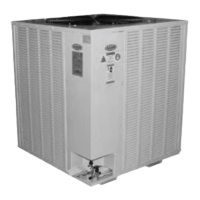Subtract the measured liquid line
temperature from the saturated temperature
to determine the liquid sub-cooling.
Compare calculated sub-cooling to Table 3
below for the appropriate unit type and
options.
Checking Evaporator Superheat
Measure the temperature of the suction line
close to the compressor.
Read gauge pressure at the suction line close
to the compressor.
Convert the pressure obtained to a saturated
temperature using the appropriate refrigerant
temperature-pressure chart.
Subtract the saturated temperature from the
measured suction line temperature to
determine the evaporator superheat.
Compare calculated superheat to Table 3
below for the appropriate unit type and
options.
Table 3 - Acceptable Refrigeration Circuit
Values
Air-Cooled Cond./Air-Source Heat Pump
Sub-Cooling with
Hot Gas Reheat**
*In cooling mode operation
**Sub-cooling must be increased by 2°F per
20 feet of vertical liquid line rise for R-410A
***Superheat will increase with long
suction line runs.
Adjusting Sub-cooling and Superheat
Temperatures
The system is overcharged if the sub-cooling
temperature is too high and the evaporator is
fully loaded (low loads on the evaporator
result in increased sub-cooling) and the
evaporator superheat is within the
temperature range as shown in Table 3 (high
superheat results in increased sub-cooling)
Correct an overcharged system by reducing
the amount of refrigerant in the system to
lower the sub-cooling.
The system is undercharged if the superheat
is too high and the sub-cooling is too low
Correct an undercharged system by adding
refrigerant to the system to reduce superheat
and raise sub-cooling.
If the sub-cooling is correct and the
superheat is too high, the TXV may need
adjustment to correct the superheat.
Special Low Ambient Option Charging
Instructions
For units equipped with low ambient control
(LAC) refrigerant flood back option being
charged when the ambient temperature is
warm:
Once enough charge has been added to get
the evaporator superheat and sub-cooling
values to the correct setting, more charge
must be added. Add approximately 80% of
the receiver tank volume to the charge to
help fill the receiver tank. The additional
charge is required for the system when
running in cold ambient conditions.
DO NOT OVERCHARGE!
Refrigerant overcharging leads to
excess refrigerant in the condenser
coils resulting in elevated compressor
discharge pressure.

